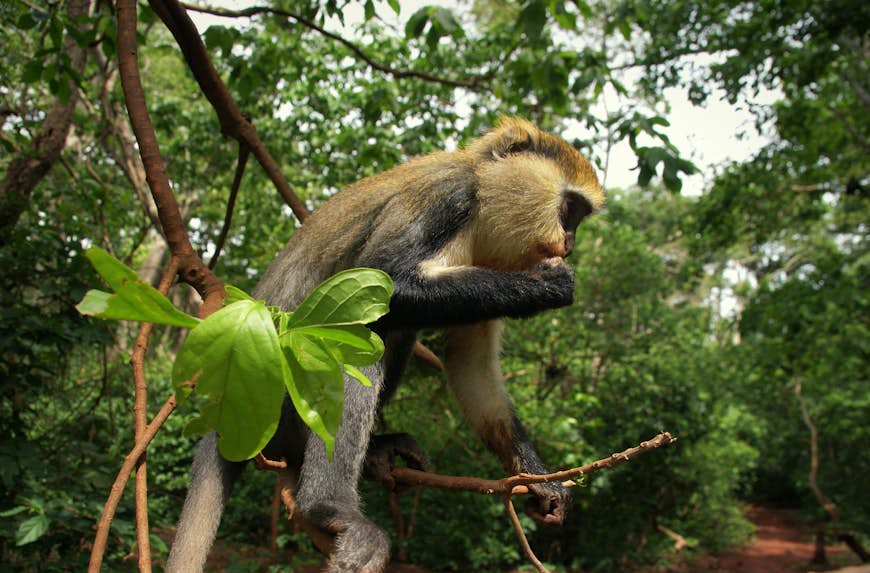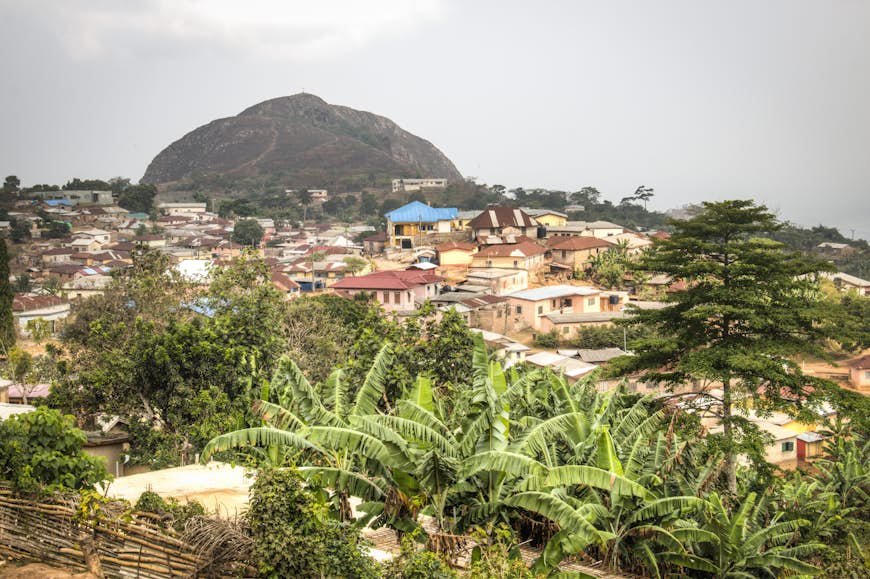Best known for its gorgeous Atlantic coastline and immense cultural wealth, Ghana is also a great destination for keen walkers.
While this compact West African may lack any showstopping hiking icons, a well-organized network of reserves and community-based ecotourism projects offers some great guided day walks in lush tropical settings inhabited by elephants, monkeys and other wildlife – and few other humans.
Here are 10 of our favorite hikes and walks in Ghana.
Mole National Park
Best hike for unforgettable elephant encounters
No fixed distance; 2–3 hours; easy
Ghana’s largest and most developed safari destination, Mole National Park extends across 4840 sq km (1870 sq miles) of dry savanna in the country’s far north. It’s home to around 90 mammal species, including some 500 elephants, 1000 buffalo and healthy numbers of warthog, baboon and antelope.
Although Mole can be explored on a network of 4WD tracks, a more exciting and immersive option is a guided walking safari. Leaving twice daily at 7am and 3:30pm, these routs regularly lead to close-up encounters with the park’s famously relaxed elephants and other wildlife. Though walking conditions are undemanding, it can get hot, and covered shoes are required as protection against snakes and other creepy-crawlies.

Wli Waterfall Trail
Best hike for hearing the roar of water (and fruit bats)
From 2.5km (1.5 miles) in each direction; 2 hours; easy (with a possible moderate-hard extension)
Purportedly the tallest waterfall in West Africa, Wli Falls tumbles 80m (260ft) over a sheer cliff into a lovely natural pool that’s perfect for swimming. The flat and winding footpath to the lower waterfall involves at least eight river crossings as it runs through Agumatsa Wildlife Sanctuary, home to plenty of birds and butterflies.
The cliffs around Wli Falls are home to a breeding colony of 500,000 straw-coloured fruit bats. They provide quite a spectacle toward dusk, when the flying mammals take wing in a frenzy of chirruping activity that almost drowns out the sound of the plunging water.
It’s possible to continue from here to the upper falls, but the steep footpath there can be treacherously slippery and is usually closed during the wet season of July to December.
Mount Afadjato
Best hike for checking another peak off your list
2km (1.2 miles) in each direction; 1.5–2 hours; moderate
Widely though not definitively regarded as Ghana’s tallest peak, Afadjato rises to 885m (2905ft) on the Togolese border some 20km (12 miles) south of Wil Falls by road. The shortest but steepest hike to the summit – climbing 350m (1150ft) over 2km (1.2 miles) – leads west from the village of Liati Wote, where guided ascents can be arranged at a local community-tourism office. From its peak, Afadjato offers memorable views over Lake Volta, with tropical monkeys, birds and butterflies are plentiful along the way up.
Lake Bosomtwe
Best hike for lakeside village-hopping
Up to 32km (20 miles) of trails; easy
Situated 35km (20 miles) southeast of the historic Ashanti capital Kumasi, Bosomtwe is an almost perfectly circular lake set in a steep-sided, million-year-old impact crater created by a meteorite strike. There’s no formal hiking trail around Bosomtwe, yet a network of local footpaths and tracks connects the various lakeshore fishing villages to each other. On the way, you’ll pass lushly cultivated slopes and patches of tangled jungle, and encounter plenty of rural Ghanaians going about their daily routines.
Kakum National Park
Best way to walk through the rainforest canopy
2.7km (1.7 miles); 1 hour; easy (but not suited to vertigo sufferers)
Ghana’s largest remaining tract of tropical rainforest is also home to its oldest and most famous canopy walkway. Suspended some 40m (131ft) above the forest floor, this 350m(1150ft)-long construction leads between seven fixed platforms attached to tall tree trunks and forms part of a short guided trail that can generally be completed in about one hour.
Crossing the walkway is a thrilling but wobbly experience that provides a unique monkey’s-eye glimpse into the rainforest canopy. It also affords the opportunity to look for spectacular forest birds such as yellow-casqued wattled hornbill and great blue turaco. Although the canopy walk is all that most visitors experience of Ghana’s most biodiverse national park, wildlife enthusiasts might want to follow it up with a longer guided walk to see a greater variety of forest wildlife on the forest floor below.
Mount Krobo
Best hike for discovering a unique hilltop cultural landscape
1.8km (1.1 miles) in each direction; 1 hour; easy
Grand views to Lake Volta and encounters with baboons are both likely on this striking inselberg (isolated hill) that towers above the main road connecting Accra to Akosombo Dam. But what makes Mount Krobo unique are the 19th-century ruins that scatter the flat and rocky tabletop. These include the remains of a former chief’s palace and a ceremonial stone that’s still used by the local Krobo people for sacrificial rites.
Bunso Arboretum
Best hike for family adventures
1–5km (.6–3.1 miles); 1–5 hours; easy
Established in 1937, the family-friendly 16.5-hectare (42-acre) Bunso Arboretum protects a patch of indigenous forest, plus an agricultural research station and botanical garden planted with palm, cacao and other introduced trees. A network of footpaths leads through attractive, bird-rich forests and plantations, as well as a herb garden and butterfly sanctuary. There’s also a canopy walkway, zip-line and children’s playground, plus horse riding and a hilltop guesthouse offering views over the forest.

Boabeng-Fiema Monkey Reserve
Best walk for frolicking with monkeys
1–3km (.6–1.9 miles); 1–2 hours; easy
This pioneering community-ecotourism site was created in 1974 by the twin villages of Boabeng and Fiema, both of which observe a long-standing taboo on killing monkeys. The reserve protects a small patch of forest inhabited by several habituated troops of two primate species: the beautiful mona monkey and acrobatic black-and-white colobus. While guided walks here don’t cover much distance, it’s easy to spend a couple of hours wandering through the forest, watching and photographing these delightful, playful creatures.
Shai Hills Resource Reserve
Best hiking close to Accra
2–10km (1.25–6.2 miles); moderate
Named after the Shai people who were evicted from the area by British colonists in 1892 and just a 90-minute drive from Accra, this fenced reserve protects a range of low hills crisscrossed by a network of dirt roads and footpaths that can be explored on guided walks with an armed ranger.
Wildlife on offer includes olive baboon, kob antelope, bushbuck and such colorful birds as Senegal parrot and the stonking great Abyssinian ground hornbill. Relics of the reserve’s former Shai inhabitants include a sacred bat cave that is partially enclosed by the remains of a stone wall constructed as part of a chief’s palace.

Amedzofe
Best hike for exploring the mountains around Ghana’s highest town
Permutations in the 2–6km (1.25–3.75 mile) range; easy to moderate
Perched at a breezy altitude of 700m (2297ft) in the Avatime Hills, Amedzofe is the closest thing in Ghana to India’s famous hill stations and one of the country’s most appealing bases for keen walkers. A helpful community ecotourism office can arrange a variety of short hikes that take in nearby waterfalls and landmarks such as Gemi Peak, the highest point in the range and topped by a prominent cross erected by missionaries in 1939.
